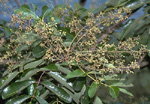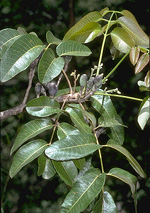 |
A moderately large, pantropical family, members of Burseraceae in Australia are found in rain forests and monsoon forests of the tropical north, from the Kimberley region to north Queensland.
Characteristic features of the family Burseraceae in Australia include: - trees and shrubs with aromatic resin canals in leaves, twigs and bark
- leaves alternate and often crowded at the branch-tips, usually pinnate with a terminal leaflet which has a thickening (pulvinus) at its base
- flowers small, greenish, in panicles
- sepals fused but petals free, actinomorphic, both 3-5 in number
- ovary superior; fruit a drupe
Description
Evergreen or deciduous trees or shrubs. Internal secretions of resin. Plants glabrous or with simple, non-glandular, unicellular hairs. Leaves alternate and spiral, petiolate; pulvinae sometimes present. Stipules present, distinct and free from the petiole, bristle-like, falling off early; stipellae present or absent. Lamina once compound, imparipinnate, rarely simple, symmetric; leaflets lanceolate, ovate, elliptic, oblanceolate, obovate or oblong; base cuneate, cordate, rounded, lobed or auriculate; margins entire or dentate, ±flat; venation pinnate, with the midrib conspicuous, and the tertiary venation reticulate; surfaces not punctate; leathery. Domatia present. Male and female flowers commonly occurring on separate plants, or with all the flowers bisexual. Inflorescences terminal or axillary, consisting of racemes or panicles. Bracts present. Flowers stalked. Floral disc present; nectaries present on the disc. Free hypanthium present or absent. Perianth regular, of 2 dissimilar whorls or rarely 1 whorl only. Calyx segments free or fused, with 3–5 sepals or lobes, valvate in bud; calyx bell-shaped, herbaceous or papery. Corolla segments free, with 3–5 petals, alternating with the sepals or calyx lobes, imbricate in bud, yellow, grey, brown or black, without contrasting markings, papery; claws absent; lobes ±entire. Fertile stamens 6 or 10, both alternating with and opposite to the sepals or calyx lobes, free or at least partly fused to the corolla, free of the ovary and style, distinct from each other or fused by their filaments into an open or closed tube, all ±equal. Staminodes present or absent. Staminal filaments sometimes distinctly flattened and with embedded anther-sacs. Anthers dorsifixed or basifixed, not versatile, opening inwards by longitudinal slits; 2-celled. Ovary superior and sessile. Carpels 3 or 5, fused; ovary with 3–5 locules. Style terminal, single and unbranched and the stigma capitate or lobed. Ovules 1–2 per locule, stalked; placentation axile. Fruit a fleshy, indehiscent drupe; the perianth on the maturing fruit deciduous. Disseminule micro-surface ±smooth, blue or black, glossy or dull. Seeds 1–5 per fruit. Aril absent. Cotyledons 2. Embryo straight or curved.
(Note: this description has been generated from the coded data compiled for the key. Any errors in the key data will be reflected in the descriptions.)
A treatment of the family Burseraceae has been published in:
Flora of Australia 25: 165-170.
Australian genera of Burseraceae (as recognised for the Flora of Australia)
Canarium
Garuga

|
  |

Canarium australianum (flowering branch)
Photo: B.Hyland © CSIRO

Canarium australianum (fruiting branch)
Photo: B.Hyland © CSIRO

Canarium australianum (fruits)
Photo: S.Pearson © S.Pearson

Canarium muelleri (fruits)
Photo: S.Pearson © S.Pearson
|
 |
|